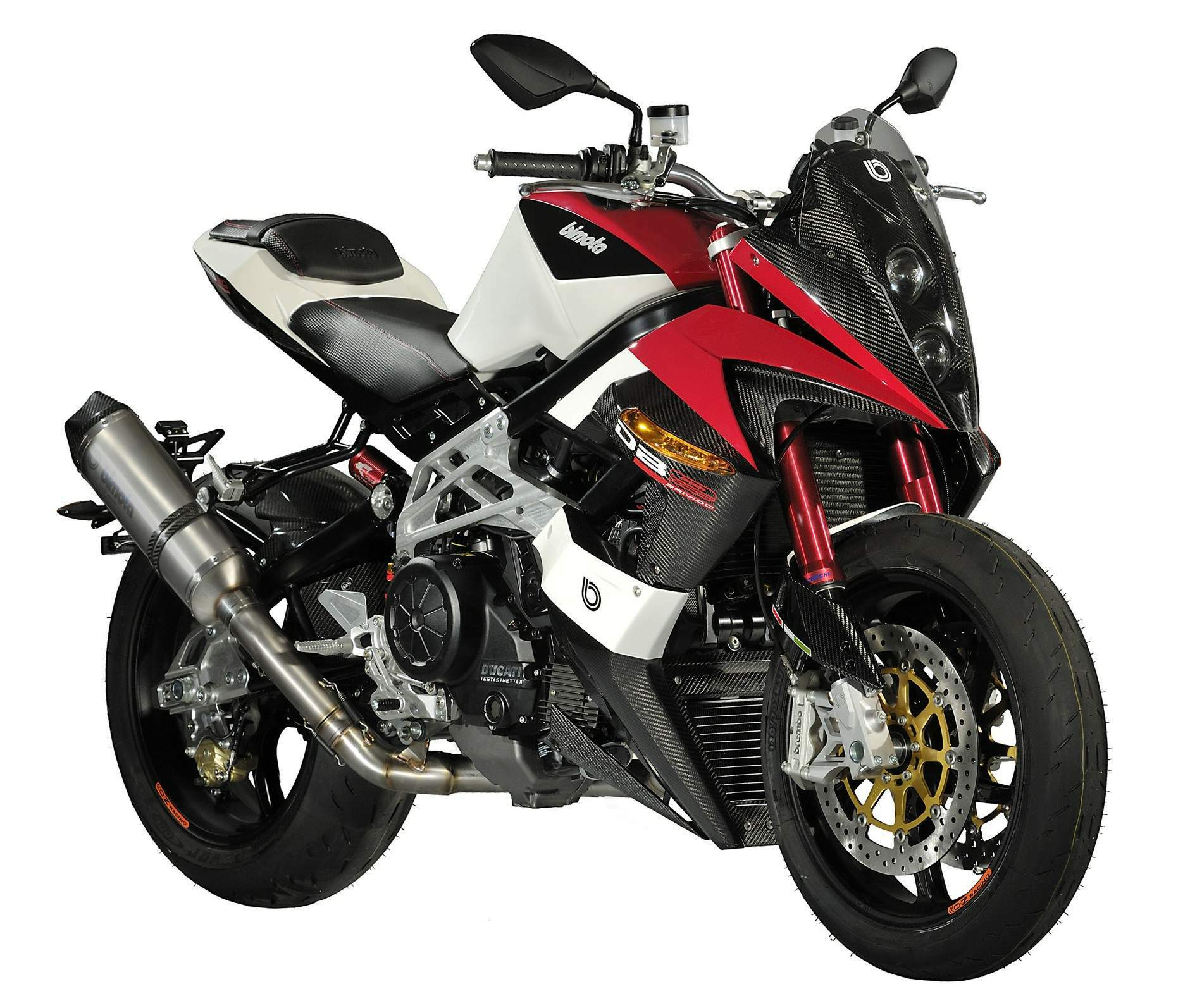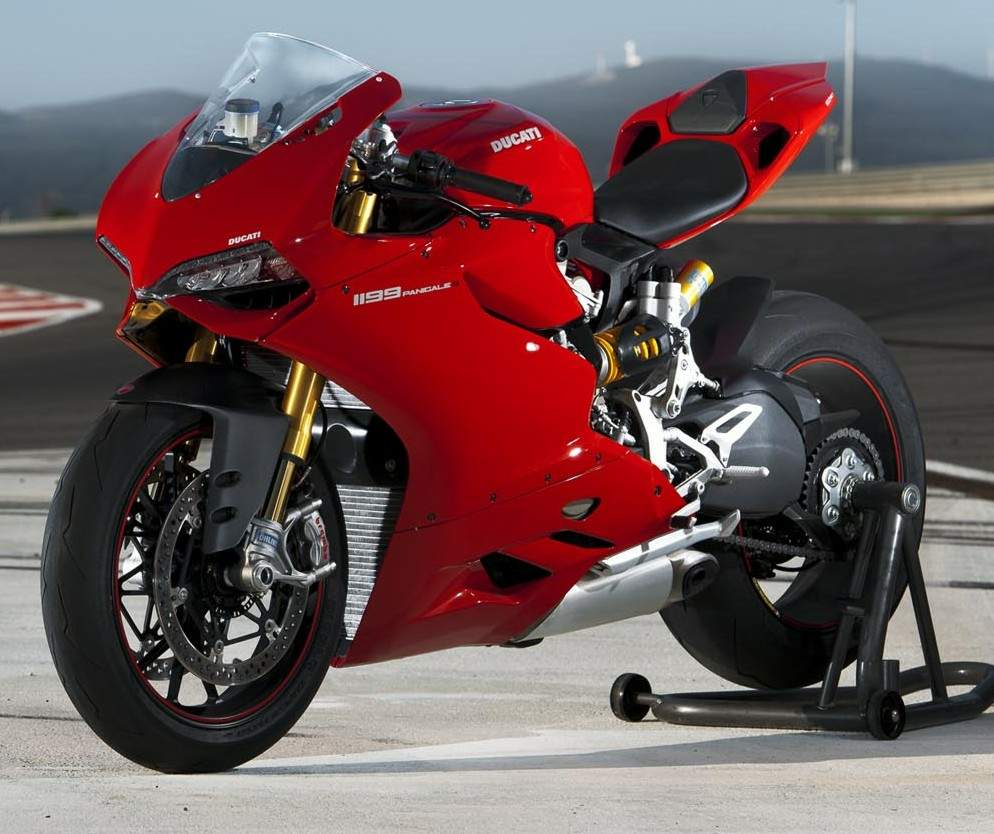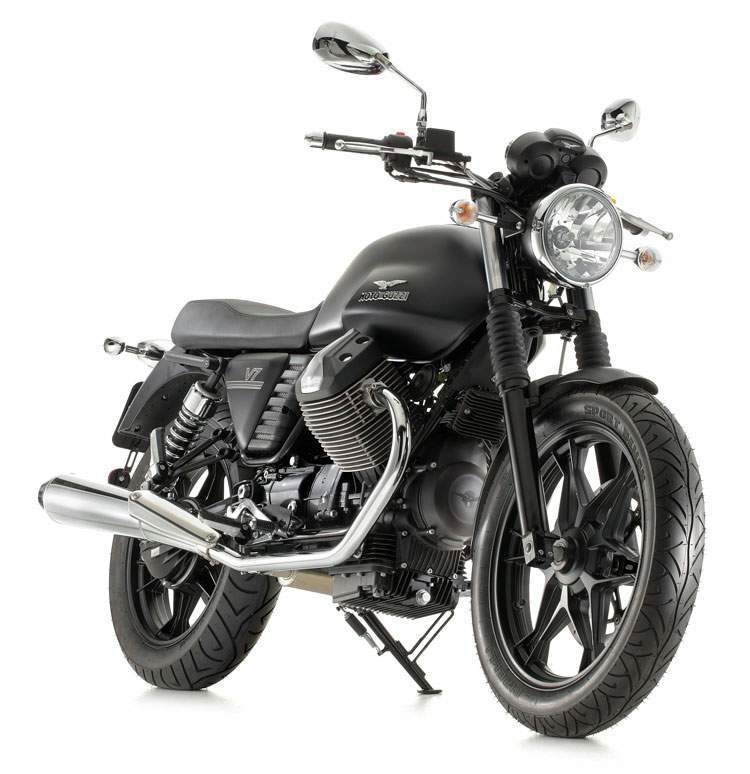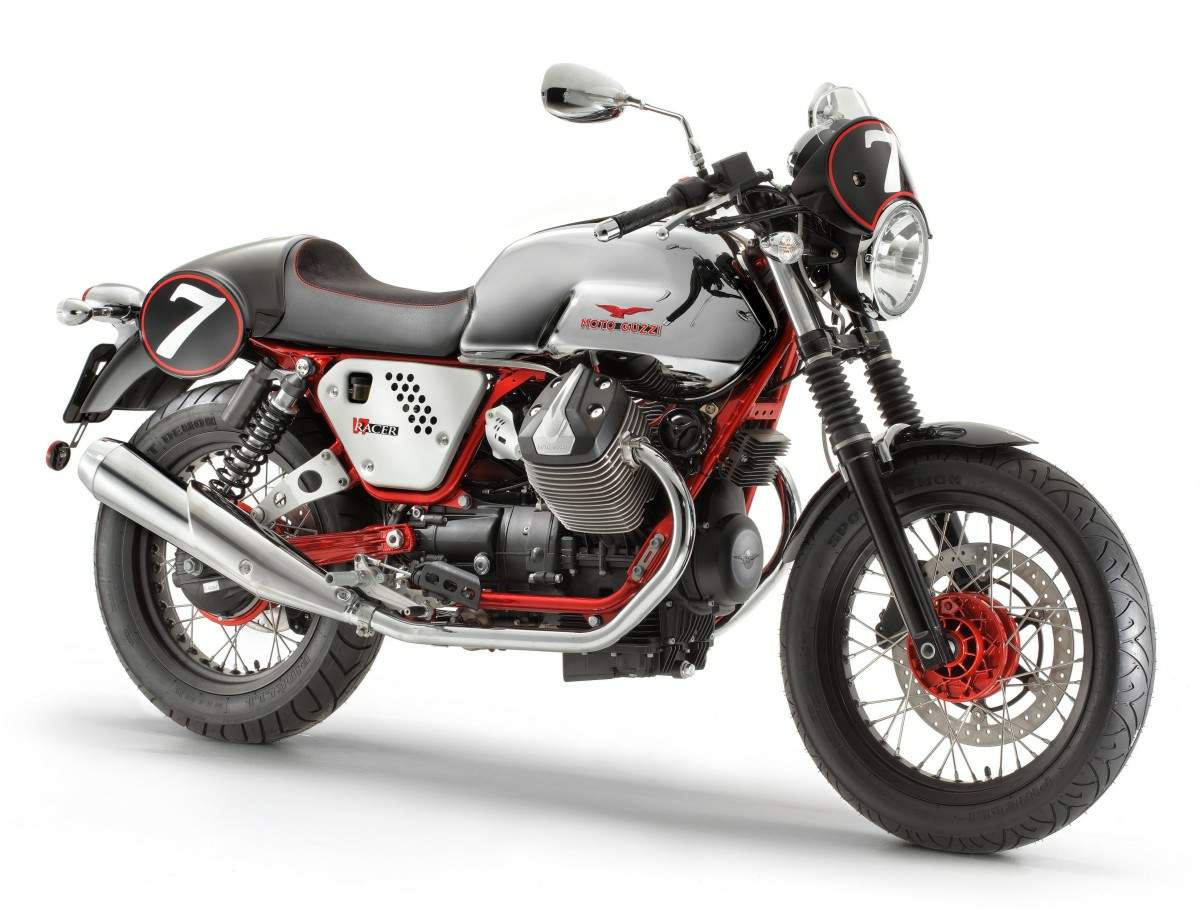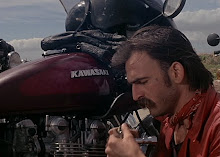With cloudy skies overhead and a temperature hovering around 60, I threw a leg over my Bonneville for a little bit of Fall riding. This Fall has been uncharacteristically warm, which means I can put off the end of the riding season. No complaints from me, I assure you.
As I was riding along admiring the thinning fall foliage, I began to think about the differences between one motorcycle and the next. You see, I've been riding my Guzzi a lot for the past few weeks, mostly because its battery is easier to install. During that time, I became used to its awkward riding position, heavy weight and prodigious power. While going along on my Bonneville today, everything was different.
For starters, the Bonneville feels like a lithe top-line center compared to the gruff defenseman feel of the Guzzi. It does this despite only being 30 lbs lighter. The Bonneville tracks along wonderfully, requiring only the slightest nudge of the handlebars to change direction. It's an easy bike to ride at any speed. On the Guzzi, you get the feeling that it's bored riding at normal speeds. I can hear the Guzzi saying to me: "faster, faster, faster."
Then there's the riding position. On the Guzzi, you're in that racy, torturous Italian riding position. The Bonneville's position is the classic standard position. With the addition of the Thruxton gel seat, this bike is a comfortable long-distance mount. The Guzzi is better on the highway, though. I get the feeling the Guzzi wants to cruise all day at 100 mph. I get the feeling that I'm pushing the Bonneville a bit at speeds over 70.
What I'm getting at is that there are more differences going from bike to bike than from car to car. I drive a lot of cars at my job and I can say that a lot of them feel the same. A lot of the steering, braking and handling has the same feel regardless of brand.
That's not to say you won't feel a bit of difference going from a Volkswagen Golf to a Ferrari 599; of course you will. If you drive multiple mid-size cars or multiple pickup trucks, though, you'll get the feeling that they were all built from some sort of mold. It's like there's a template that says a compact car should feel like this, or that a full-size luxury car should feel like this. It kind of takes the fun out of driving. I think cars are starting to look the same, too.
I've owned and ridden numerous bikes and I can say they've all felt different. A Harley feels different than a BMW, which feels different from a Yamaha. Each bike manufacturer does things their own way and that is evidenced in their products. It makes for interesting products and gives each bike its own character. Each new bike you ride is a new experience. It's not like going from car to car, where you adjust the seat and the mirrors and drive off.
Going from bike to bike, you have to learn the nuances of the new bike. You have to learn what it likes and what it doesn't like. Cars have been engineered to adapt to you. Many cars have memory seats to adapt to your size and have transmissions that adapt to your driving style. You don't get that on a bike. It's up to you to adapt to the bike. It's like going to bed with someone new. It's a bit rocky at first while you each figure out what the other person likes and doesn't like. Once you find it, the magic happens. Sometimes the magic happens too quickly but never mind that.
The differences between each bike is yet another reason why motorcycling is so interesting and so much fun. It's just a shame there isn't more time to sample the differences between bikes. Such is life.
Sunday, November 20, 2011
Friday, November 18, 2011
It's a Great Time to Ride Italian
Motorcycling's cup has runneth over with Italian bikes at the Milan International Motorcycle Show. Bimota released a bunch of new bikes, Ducati debuted some new bikes including the 1199 Panigale and Moto Guzzi revamped the V7 line for 2012. This is great news for Italophiles everywhere.
First up from Bimota is the DB10 Bimotard based on the Ducati Hypermotard. The air-cooled Ducati L-Twin remains and it bears a vague resemblance to the Hypermotard. The similarities end there. It's awash in carbon fiber and has a hand-formed trellis frame holding the bike together. Fully-adjustable suspension is standard, naturally, and it consists of 50mm Marzocchi forks up front and an Extreme Tech shock out back. There are also giant radial Brembos to make sure you stop before you hiy whatever you're screaming toward. Bimota claims a dry weight of 369 lbs, 10 pounds less than the standard Hypermotard.
Bimota's entry into the naked bike segment is the DB9 Brivido, based upon the Ducati Streetfighter. This model is also awash in carbon fiber but is built around the liquid-cooled 1198cc twin that blasts out 162 hp. Yes, it has fully-adjustable suspension from Marzocchi and Extreme Tech but this time the front forks are 43mm, compared to the 50mm forks on the Bimotard. Stopping all this carbon fiber are the same big Brembos but this time they're bolted to lightweight wheels from O.Z.
If you were expecting another Ducati-based Bimota, you're in for a disappointment. The final new Bimota released is a dirt bike called the BBX300. It has the hand-formed chassis you'd expect from Bimota but it has something you didn't: a two-stroke engine built in-house. Normally, Bimota builds their bikes around the engines of other manufacturers. Bimota tried their hand at building a two-stroke in-house with the V Due back in the 90s. The bike was a mess and never really worked properly. Let's hope the new engine works out.
From Ducati, all eyes were on the 1199 Panigale. This bike is the replacement for not only the 1198 but also for the Testastretta engine that has served Ducati well for so many years. The Testastretta can trace its roots all the way back to the Ducati Pantah, which debuted in 1980. The engine in the Pantah was 500cc, air-cooled and SOHC. Over the course of 30 years, the engine came to have 1198cc, liquid-cooling, DOHC and 170 hp.
The new engine is 1199cc and pumps out 195 hp, making it the most powerful twin cylinder engine you can buy. This engine heralds another change for Ducati: the ubiquitous L-Twin is no more. The V-Twin's cylinders are still 90 degrees apart but they have been rotated back, resembling a typical V-Twin arrangement.
Surrounding the engine is an all-new monocoque chassis, giving the bike a dry weight of 362 lbs. That's astonishing, especially with an engine that puts out 195 hp. The Panigale is also overflowing with three letter acronyms like ABS, DTC, DES, DQS, EBC, RbW and TFT. It's best to get the monoposto version so you don't bore your passenger while explaining all the acronyms.
Ducati also showed the Diavale Chromo, which is a restyling of the Diavale. Basically, they gave the tank a black-chrome effect, covered the rest of the bike in black paint and hiked up the price. Next to the Chromo was the 848 Evo Corsa Special Edition. This 848 has an Ohlins shock out back, special paint, bigger brakes, traction control, quick shifter and a really long name.
From Mandello del Lario comes a refreshed V7 in all-black paint. The spoked wheels have been replaced by mags, which are, you guessed it, black. The new V7 has a new 750cc engine with a single throttle body and a bump up in compression. 70% of this engine is completely new, including the throwback valve covers. All of this leads to more torque and a jump to 51 hp. Over all, the V7 is still absolutely gorgeous, still too slow and still too expensive.
Following the regular V7 is a Special Edition model with different paint and the same specs and the Racer. The Racer (above) takes the place of the V7 Cafe Classic and has a chrome gas tank, a special seat, clip-ons and a small flyscreen above the headlamp. You might be interested in the new spoked wheels that reduce weight by 1,440 grams up front and 860 grams in the back. To put those numbers in perspective, that's less than Ozzy Osbourne's daily cocaine intake during the 1970s. Overall, the Racer is a ghastly replacement for the classically beautiful Cafe Classic. At least it has more power.
First up from Bimota is the DB10 Bimotard based on the Ducati Hypermotard. The air-cooled Ducati L-Twin remains and it bears a vague resemblance to the Hypermotard. The similarities end there. It's awash in carbon fiber and has a hand-formed trellis frame holding the bike together. Fully-adjustable suspension is standard, naturally, and it consists of 50mm Marzocchi forks up front and an Extreme Tech shock out back. There are also giant radial Brembos to make sure you stop before you hiy whatever you're screaming toward. Bimota claims a dry weight of 369 lbs, 10 pounds less than the standard Hypermotard.
Bimota's entry into the naked bike segment is the DB9 Brivido, based upon the Ducati Streetfighter. This model is also awash in carbon fiber but is built around the liquid-cooled 1198cc twin that blasts out 162 hp. Yes, it has fully-adjustable suspension from Marzocchi and Extreme Tech but this time the front forks are 43mm, compared to the 50mm forks on the Bimotard. Stopping all this carbon fiber are the same big Brembos but this time they're bolted to lightweight wheels from O.Z.
If you were expecting another Ducati-based Bimota, you're in for a disappointment. The final new Bimota released is a dirt bike called the BBX300. It has the hand-formed chassis you'd expect from Bimota but it has something you didn't: a two-stroke engine built in-house. Normally, Bimota builds their bikes around the engines of other manufacturers. Bimota tried their hand at building a two-stroke in-house with the V Due back in the 90s. The bike was a mess and never really worked properly. Let's hope the new engine works out.
From Ducati, all eyes were on the 1199 Panigale. This bike is the replacement for not only the 1198 but also for the Testastretta engine that has served Ducati well for so many years. The Testastretta can trace its roots all the way back to the Ducati Pantah, which debuted in 1980. The engine in the Pantah was 500cc, air-cooled and SOHC. Over the course of 30 years, the engine came to have 1198cc, liquid-cooling, DOHC and 170 hp.
The new engine is 1199cc and pumps out 195 hp, making it the most powerful twin cylinder engine you can buy. This engine heralds another change for Ducati: the ubiquitous L-Twin is no more. The V-Twin's cylinders are still 90 degrees apart but they have been rotated back, resembling a typical V-Twin arrangement.
Surrounding the engine is an all-new monocoque chassis, giving the bike a dry weight of 362 lbs. That's astonishing, especially with an engine that puts out 195 hp. The Panigale is also overflowing with three letter acronyms like ABS, DTC, DES, DQS, EBC, RbW and TFT. It's best to get the monoposto version so you don't bore your passenger while explaining all the acronyms.
Ducati also showed the Diavale Chromo, which is a restyling of the Diavale. Basically, they gave the tank a black-chrome effect, covered the rest of the bike in black paint and hiked up the price. Next to the Chromo was the 848 Evo Corsa Special Edition. This 848 has an Ohlins shock out back, special paint, bigger brakes, traction control, quick shifter and a really long name.
From Mandello del Lario comes a refreshed V7 in all-black paint. The spoked wheels have been replaced by mags, which are, you guessed it, black. The new V7 has a new 750cc engine with a single throttle body and a bump up in compression. 70% of this engine is completely new, including the throwback valve covers. All of this leads to more torque and a jump to 51 hp. Over all, the V7 is still absolutely gorgeous, still too slow and still too expensive.
Following the regular V7 is a Special Edition model with different paint and the same specs and the Racer. The Racer (above) takes the place of the V7 Cafe Classic and has a chrome gas tank, a special seat, clip-ons and a small flyscreen above the headlamp. You might be interested in the new spoked wheels that reduce weight by 1,440 grams up front and 860 grams in the back. To put those numbers in perspective, that's less than Ozzy Osbourne's daily cocaine intake during the 1970s. Overall, the Racer is a ghastly replacement for the classically beautiful Cafe Classic. At least it has more power.
Saturday, November 5, 2011
Going Naked with MV Agusta
All three people who read this blog have probably figured out by now that I like MV Agusta's bikes. They are fantastically beautiful Italian exotica and that really turns me on. So I guess it was only a matter of time before a post about the 675 Brutale made it on here.
Well, the wait is over.
A few days ago, the 675 Brutale was introduced to the world and my body temperature has just now begun to cool down to normal levels. The bike is just gorgeous. It's stylish, modern, detailed, aggressive, restrained, classic, avant garde, unmistakable and provocative. Above all, though, it's quintessentially Italian.
The bodywork and the frame come together in a seamless fashion. On a lot of naked bikes, the body looks like a bit of plastic plopped on the frame. It looks like an afterthought. On the 675 Brutale, the bodywork and the frame are woven together, as they should be.
MV has also done some interesting things with the Brutale's colors. The plastic side panels on the seat can be had in beige and silver and the seat can be had in brown or black. The contrast in colors of the white bike with beige panels and a brown seat looks really good. Far too many bikes today are covered with a boring coat of black. It's nice to see some different colors and some new options with contrasting colors. The Brutale does have some black plastic around the radiator but that's inevitable. At least the engine is silver.
What really tickles my fancy are the exhausts. MV's F4 line, with its four pipes sticking out from under the seat, held the crown for best-looking exhaust. The 675 line might challenge that, though. The three short pipes poke out of the right side of the bike like guns on a WWII fighter. They even come with bronze tips. I can already hear the scorching wail of the three-cylinder engine just by glancing at the exhaust.
Yes, that's right; MV Agusta has a 675cc triple just like some other European motorcycle company. Unlike that other company's triple, which makes 105 hp, the MV's triple makes 115 hp. It also makes 52 lb/ft of torque, which is two more. The MV, though, makes its power and torque higher in rev range. The MV might be lighter or heavier and that could make a difference. I don't know which bike is heavier because the other company publishes wet weight and MV publishes dry weight. I'll just say the Brutale 675 weighs 358 lbs dry and move on.
Surrounding the engine is a frame made from steel tubing and aluminum. Attached to the frame are 43mm upside-down forks at the front and a single-sided swingarm with a Sachs shock at the back. Halting forward progress are big 320mm radial brakes from Brembo. The front calipers have four pistons each, as if you couldn't guess.
The mechanical specs are all very nice but what gets me is the traction control. It's called MVICS and it has eight settings. How many settings do you need? I wonder if I can think of eight settings. Here goes: off, sport, race, tarmac, gravel, snow, power slide and donut. Anyway, what's wrong with two settings: off and on?
And there a few other niggles to point out. The rear fender looks like a crane hanging off the back. It's like a big sign saying "this is here because the law says it has to be here." I imagine most owners will chuck it in the trash immediately.
And not even MV's team of Michelangelos can make a catalytic converter look visually appealing. It's like a blob of metal stuck on the bottom of the bike. Also visually unappealing is the LCD dashboard. The face looks like something you'd find on a treadmill and its placement above the headlamp is awkward.
None of these niggles, though, distract from the overall goodness of the Brutale 675. MV continues to bring out gorgeous new pieces of art brimming with technology and speed. Here's hoping that trend continues.
Is the 675 Brutale the best-looking naked? It's hard to argue against it. I like the white paint, brown seat and beige side panels. The contrasting colors go together well and give the bike a touch of class missing in other sporty nakeds.
Of course the bike looks best from this angle. Look at the exhausts. They look like they're ready to unleash a burst of .50 cal on some unsuspecting ground targets. I like the wheels, too.
Well, the wait is over.
A few days ago, the 675 Brutale was introduced to the world and my body temperature has just now begun to cool down to normal levels. The bike is just gorgeous. It's stylish, modern, detailed, aggressive, restrained, classic, avant garde, unmistakable and provocative. Above all, though, it's quintessentially Italian.
The bodywork and the frame come together in a seamless fashion. On a lot of naked bikes, the body looks like a bit of plastic plopped on the frame. It looks like an afterthought. On the 675 Brutale, the bodywork and the frame are woven together, as they should be.
MV has also done some interesting things with the Brutale's colors. The plastic side panels on the seat can be had in beige and silver and the seat can be had in brown or black. The contrast in colors of the white bike with beige panels and a brown seat looks really good. Far too many bikes today are covered with a boring coat of black. It's nice to see some different colors and some new options with contrasting colors. The Brutale does have some black plastic around the radiator but that's inevitable. At least the engine is silver.
What really tickles my fancy are the exhausts. MV's F4 line, with its four pipes sticking out from under the seat, held the crown for best-looking exhaust. The 675 line might challenge that, though. The three short pipes poke out of the right side of the bike like guns on a WWII fighter. They even come with bronze tips. I can already hear the scorching wail of the three-cylinder engine just by glancing at the exhaust.
Yes, that's right; MV Agusta has a 675cc triple just like some other European motorcycle company. Unlike that other company's triple, which makes 105 hp, the MV's triple makes 115 hp. It also makes 52 lb/ft of torque, which is two more. The MV, though, makes its power and torque higher in rev range. The MV might be lighter or heavier and that could make a difference. I don't know which bike is heavier because the other company publishes wet weight and MV publishes dry weight. I'll just say the Brutale 675 weighs 358 lbs dry and move on.
Surrounding the engine is a frame made from steel tubing and aluminum. Attached to the frame are 43mm upside-down forks at the front and a single-sided swingarm with a Sachs shock at the back. Halting forward progress are big 320mm radial brakes from Brembo. The front calipers have four pistons each, as if you couldn't guess.
The mechanical specs are all very nice but what gets me is the traction control. It's called MVICS and it has eight settings. How many settings do you need? I wonder if I can think of eight settings. Here goes: off, sport, race, tarmac, gravel, snow, power slide and donut. Anyway, what's wrong with two settings: off and on?
And there a few other niggles to point out. The rear fender looks like a crane hanging off the back. It's like a big sign saying "this is here because the law says it has to be here." I imagine most owners will chuck it in the trash immediately.
And not even MV's team of Michelangelos can make a catalytic converter look visually appealing. It's like a blob of metal stuck on the bottom of the bike. Also visually unappealing is the LCD dashboard. The face looks like something you'd find on a treadmill and its placement above the headlamp is awkward.
None of these niggles, though, distract from the overall goodness of the Brutale 675. MV continues to bring out gorgeous new pieces of art brimming with technology and speed. Here's hoping that trend continues.
Is the 675 Brutale the best-looking naked? It's hard to argue against it. I like the white paint, brown seat and beige side panels. The contrasting colors go together well and give the bike a touch of class missing in other sporty nakeds.
Of course the bike looks best from this angle. Look at the exhausts. They look like they're ready to unleash a burst of .50 cal on some unsuspecting ground targets. I like the wheels, too.
Subscribe to:
Comments (Atom)

